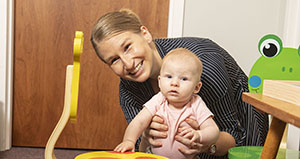Current Projects
Newborn Cognitive and Motor Development
Some infants are at an increased risk for developmental differences throughout their lifetime, including basic measures of infant growth, deficits in spatial attention, social and emotional processes, information processing speed, motor performance, and neurobehavior. Our project is interested in whether prenatal opioid and/or other substance exposures are associated with meaningful developmental differences. We hope this research will contribute to early identification of infants at risk for delays and inform future intervention efforts.
Related Publications
Boynewicz, K., Campbell, S., & Chroust, A. (2023). Early identification of atypical motor performance of infants with prenatal opioid exposure. Physical Therapy & Rehabilitation Journal, 35(3), 359-365. DOI: 10.1097/PEP.0000000000001021
NOWS Database
Related Publications
Hite, M.K., Chroust, A., Proctor-Williams, K. & Lowe, J. ^ (2024). Newborn Hearing Screening Results for Infants with In-Utero Opioid Exposure in Southern Appalachia. Journal of Speech Language and Hearing Research, 67(4), 1268-1280. https://doi.org/10.1044/2024_JSLHR-23-00492
Bailey, B.A., Chroust, A., Justice, N., & Wood, D. (2023). Which newborns need monitoring for neonatal opioid withdrawal syndrome (NOWS)? Utilization and accuracy of methods to assess pregnancy opioid use. Journal of Substance Use, 1-6. https://doi.org/10.1080/14659891.2023.2261054
Gersch, H.^, Shah, D., Chroust, A., Wood, D., & Bailey, B. (2023). Can umbilical cord testing add to maternal urine drug screen for evaluation of infants at risk of neonatal opioid withdrawal syndrome? The Journal of Maternal-Fetal & Neonatal Medicine, 36(1) 221706. DOI: 10.1080/14767058.2023.2211706
Shah, D., Turner, E.^, Chroust, A., Duvall, K., Wood, D., & Bailey, B. (2022). Marijuana use in opioid-exposed pregnancy increases risk of preterm birth. The Journal of Maternal-Fetal & Neonatal Medicine, 35(2), 8456-8461. https://doi.org/10.1080/14767058.2021.1980532
Empowering Care for Pregnant Individuals with Opioid Use Disorder: An Evaluation and Training Initiative
This project aims to evaluate the care of pregnant individuals with opioid use disorder
(OUD) at the ETSU Health OBGYN clinic. Specifically, we will systematically study
the effectiveness of various medication assisted treatment interventions during pregnancy,
focusing on maternal health, neonatal/infant outcomes across pregnancy and 12 mo postpartum.
OAC Proposal Evidence Base References
Relevant Team Member Publications
Expansion of ETSU Baby Steps Clinic
Our interdisciplinary team was recently awarded an Opioid Abatement Council grant from the State of Tennessee to help facilitate the expansion of a follow-up clinic for infants and families with prenatal substance exposure. In my role as Project Director, I will work with clinical team members to implement the project as detailed in our grant proposal. I will also lead related research and evaluation projects.
Meta-Analyses and Content Analyses
Our lab is currently completing a meta-analysis of motor interventions using the Test of Infant Motor Performance (TIMP) as an outcome measure. We have registered the protocol using PROSPERO (CRD42023414447). Links to supporting documents related to the meta-analysis will be available here.
Full list of all studies included in the meta-analysis.
Our lab is currently completing a content analysis of educational materials available to caregivers of infants and young children diagnosed with NAS or with prental substance exposure.
Early Interventionists
This is a mixed method research project that is sponsored by ETSU’s Center of Excellence in Early Childhood Learning and Development. The overall goal of the project is to examine the experiences of early interventionists across the state of Tennessee who work with children with a history of prenatal drug exposure.
Our Procedures
Eye-tracking
Infant visual attention is one of the most fundamental aspects of infant learning, as preverbal infants learn almost everything about the world through their eyes. By understanding what grabs and holds your baby's attention, we can begin to unravel the marvels of infant learning. By using eye-tracking technology, we can measure where your baby is looking, how quickly they move their eyes, and how long they look. By examining these aspects of infant visual attention, we hope to gain a better understanding of how attention influences memory and learning.
This is an example of performance during an eye-tracking task. The red circle represents where the participant was looking--the larger the circle, the longer the participant looked to that specific location. Advancements in visual eye tracking technology have allowed researchers to ask all kinds of exciting new questions!


 Stout Drive Road Closure
Stout Drive Road Closure